Quarterly Financial Accounts
The Quarterly Financial Accounts (QFA) present a complete and consistent set of quarterly financial data for all sectors of the Irish economy. They provide comprehensive information on the financial and investment activities of households, non-financial corporations, financial corporations, government and the rest of the world. The whom-to-whom tables provide information on the interactions between these sectors.
Key Points – Q2 2025
Publication date: 23 October 2025
-
The Irish economy remained a net lender in Q2 2025, with a net lending position of €36.8bn.
- Financial corporations were net borrowers in the quarter, mainly due to the large borrowing position of captive financial institutions within the “other financial institutions” subsector.
- Total liabilities of non-financial corporations decreased by €199.8bn (7 per cent) over the quarter. This was primarily driven by a reduction in unlisted shares.
- The net financial wealth of households increased by €20.5bn during the quarter. This was largely due to positive asset revaluations for €11.7bn.
- Government liabilities stood at €236.8bn and assets at €143.5bn as of Q2 2025. This resulted in a net financial wealth position above -€100bn for the first time since Q2 2011.
In addition to the latest Q2 2025 data, this release incorporates revisions for reference periods Q1 2013 to Q1 2025 that took place as part of the regular annual revisions of Irish macroeconomic statistics.
Chart 1: Net Financial Transactions of the Overall Irish Economy
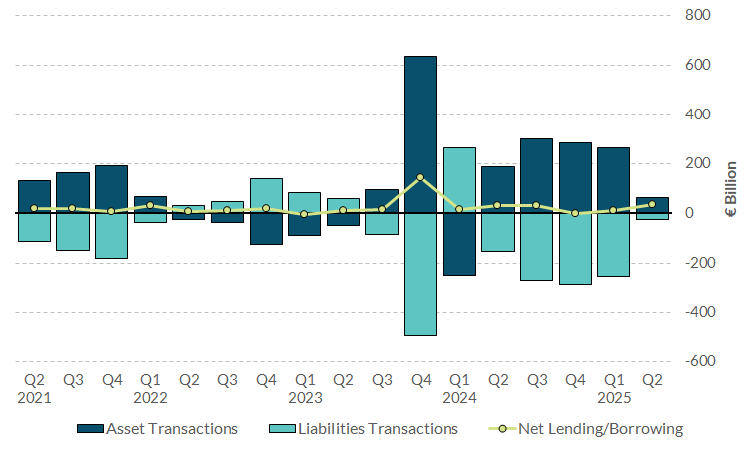 Note: the data for Q4 2023 included in the above chart will be subject to revisions in the next publication.
Note: the data for Q4 2023 included in the above chart will be subject to revisions in the next publication.
View data for chart 1 | xlsx 21 KB
Overall, the Irish economy remained a net lender in the period, as net investment in financial assets exceeded the net incurrence of financial liabilities by €36.8bn.
Positive transactions in debt securities (€71.0bn), equity (€52.6bn), as well as in deposits (€39.2bn) were the main contributors to the increase in financial assets in the period. By the end of Q2 2025, the total stock of financial assets of the domestic economy had risen to €12,478bn.
Transactions in liabilities were primarily related to investment fund shares (€76.6bn). Total liabilities stood at €12,838bn, down €67.4bn when compared to the previous quarter.
The difference between total assets and liabilities of the Irish economy results in a net financial wealth position of -€360.8bn, increasing by €68.1bn since the previous quarter.
Financial corporations accounted for approximately 78 per cent of total financial assets in Ireland, with investment funds alone representing 38 per cent of the total.
Chart 2: Borrowing and Lending across Sectors of the Irish Economy
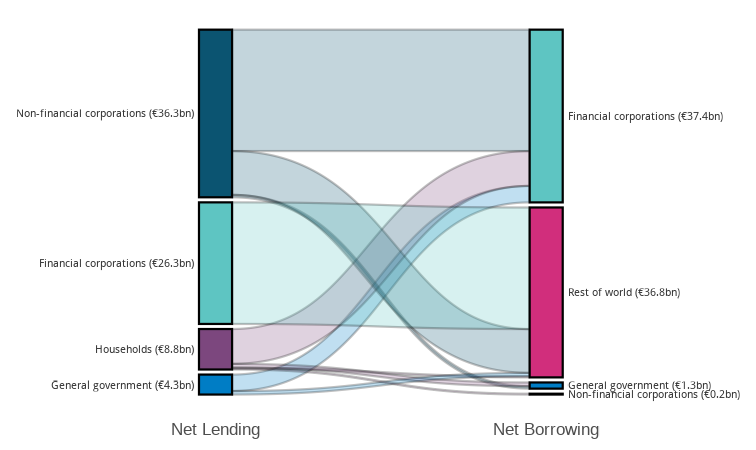
View data for chart 2 | xlsx 16 KB
With €36.1bn, non-financial corporations (NFCs) reported a larger net lending position than both the household and the government sector in Q2 2025.
Financial corporations were net lenders vis-à-vis the rest of the world, but net borrowers with NFCs, households and the government. This resulted in an overall net borrowing position for this sector totalling -€11.1bn.
Chart 3: Net Transactions of Irish Financial Corporations
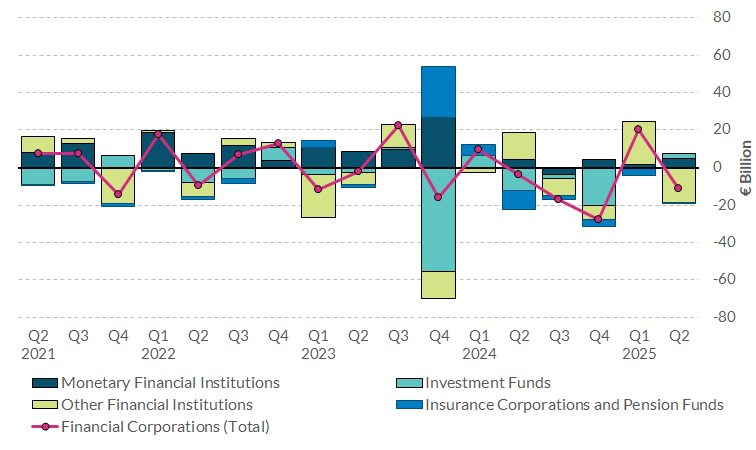 Note: the data for Q4 2023 included in the above chart will be subject to revisions in the next publication.
Note: the data for Q4 2023 included in the above chart will be subject to revisions in the next publication.
View data for chart 3 | xlsx 21 KB
Monetary financial institutions and investment funds were both net lenders in Q2 2025 at €4.9bn and €2.8bn, respectively. For the former, the overall position was driven by the extension of loans to foreign counterparts and the acquisitions of debt securities. Investment funds reported positive investment in listed shares.
Other financial institutions (OFIs) were net borrowers in the period (-€18.6bn). Within OFIs, the movement in the period can be largely ascribed to captive financial institutions receiving loans from foreign counterparts.
Insurance corporations and pension funds were only marginally net borrowers (-€0.1bn), with both sectors reporting generally moderate movements in the quarter.
Chart 4: Funding of Irish NFC's and their Liabilities Transactions
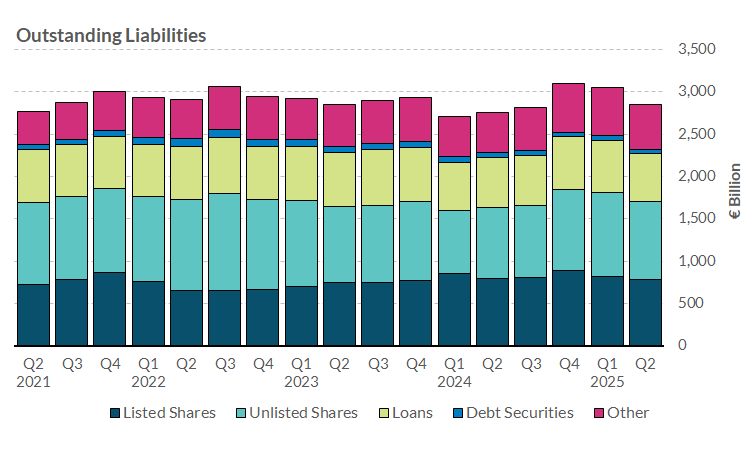
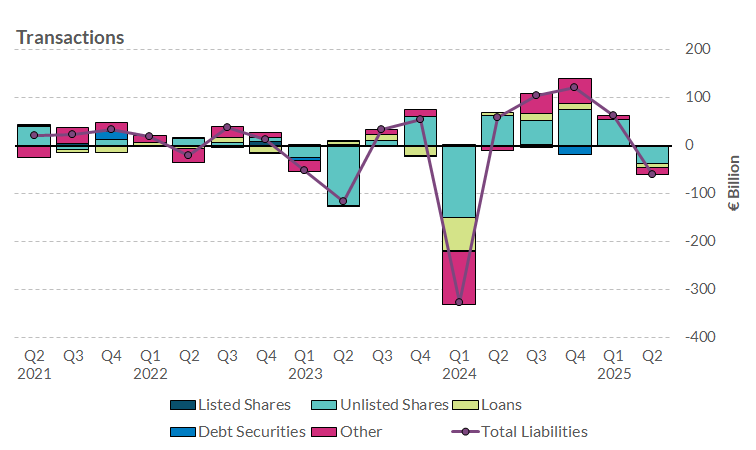
View data for chart 4 | xlsx 18 KB
Total liabilities of Irish NFCs decreased by €199.8bn (equal to 7 per cent) compared to the end of the previous quarter, to stand at €2,855bn. This was primarily driven by a reduction in unlisted shares of €78.8bn.
Despite this, equity remained the main source of funding for NFCs, with listed and unlisted shares amounting to around 60 per cent of the sector’s total liabilities.
Furthermore, NFCs’ debt (loans and debt securities liabilities) stood at €617.5bn in Q2 2025, decreasing from the previous quarter by €52.9bn.
Chart 5: Change in Households' Financial Net Wealth
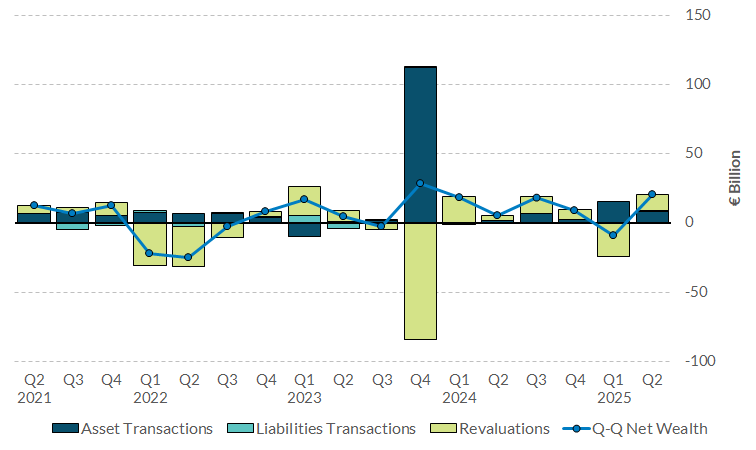
Note: the data for Q4 2023 included in the above chart will be subject to revisions in the next publication.
View data for chart 5 | xlsx 19 KB
The financial net wealth of Irish households increased by €20.5bn in the quarter, to reach €414.3bn. Revaluations and other changes contributed €11.7bn to this movement, while investment in financial assets totalled €8.6bn.
Households’ total financial assets stood at €570.3bn, an increase of €37.6bn from the end of the previous quarter. This was mainly driven by an increase in deposits (€3.7bn) and investment in insurance and pension entitlements (€4.1bn), as well as revaluations of equity holdings (€23.7bn).
Total households’ liabilities stood at €156.1bn at the end of Q2 2025. Over the quarter, the uptake of liabilities was marginal (€0.2bn). Long-term loans accounted for 95 per cent of overall household liabilities in Ireland.
The household debt-to-GDP ratio stood at 24 per cent, increasing from the previous quarter. This is due to the effect of an overall rise in household debt, partially offset by an increase in annualised GDP.
Chart 6: Government Debt and Composition
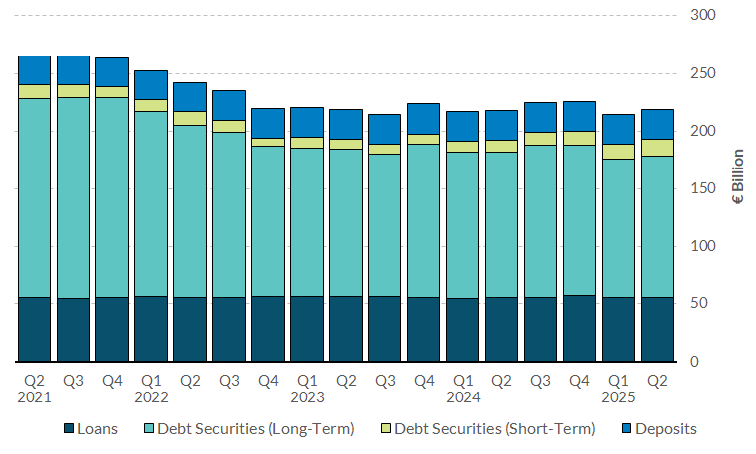 View data for chart 6 | xlsx 22 KB
View data for chart 6 | xlsx 22 KB
Irish government debt increased by €4.3bn in Q2 2025, to stand at €218.6bn.
Transactions in government financial assets totalled €5.3bn over the quarter. This was mainly driven by new deposits (€6.7bn) and was partially offset by the disposal of listed shares (- 1.9bn).
The acquisition of liabilities in the period equalled €2.3bn, with the main movement being an increase of €1.3bn in long-term debt securities.
Government financial assets stood at €143.5bn as of Q2 2025, while liabilities totalled €236.8bn. This resulted in a net financial wealth position of -€93.3bn at the end of the quarter, and the first time since Q2 2011 that the net financial wealth of the Irish government was above -€100bn.
Have your say: take our survey to help improve our Statistics website
Data
Quarterly Financial Accounts for Ireland Q2 2025 | pdf 496 KB
Financial Accounts for Ireland | xls 19323 KB
Whom-to-whom Tables | xls 18606 KB
Publication Notes | pdf 238 KB
Glossary | pdf 426 KB